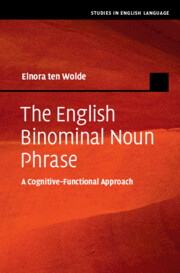Book contents
- The English Binominal Noun Phrase
- Studies in English Language
- The English Binominal Noun Phrase
- Copyright page
- Dedication
- Contents
- Figures
- Tables
- Acknowledgments
- Abbreviations
- Chapter 1 Introduction
- Part I Categorization
- Part II Testing the Hypothesis
- Chapter 6 Diachronic Evidence
- Chapter 7 Premodification Evidence
- Part III Theoretical Analysis
- Part IV Discussion
- References
- Index
Chapter 7 - Premodification Evidence
from Part II - Testing the Hypothesis
Published online by Cambridge University Press: 29 June 2023
- The English Binominal Noun Phrase
- Studies in English Language
- The English Binominal Noun Phrase
- Copyright page
- Dedication
- Contents
- Figures
- Tables
- Acknowledgments
- Abbreviations
- Chapter 1 Introduction
- Part I Categorization
- Part II Testing the Hypothesis
- Chapter 6 Diachronic Evidence
- Chapter 7 Premodification Evidence
- Part III Theoretical Analysis
- Part IV Discussion
- References
- Index
Summary
This study has proposed that [N of a] unit in the evaluative modifier and binominal intensifier, and to some degree the evaluative binominal noun phase, shares formal and functional features with premodifiers. If this is true, this unit should have integrated into the preexisting premodification patterns in front of N2, and evidence of this change can be shown in the distribution of the premodifiers in the six of-binominals. This is tested using a dataset compiled from COCA consisting of 3,433 premodifier of-binominal tokens and Ghesquière’s (2014) zone-based premodifier classification. A Hierarchical Configural Frequency Analysis was conducted to explore the premodification patterns of each construction. The findings show that all six of-binominals demonstrate different premodification patterns and corroborates the findings that each are separate constructions. Furthermore, the evidence substantiates the claim that [N of a] forms a separate unit and is situated in the appropriate place in front of N2. It also demonstrates that these two constructions follow the grammaticalization path of more canonical premodifiers.
Keywords
- Type
- Chapter
- Information
- The English Binominal Noun PhraseA Cognitive-Functional Approach, pp. 157 - 200Publisher: Cambridge University PressPrint publication year: 2023

